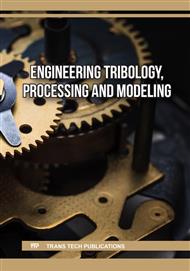p.3
p.17
p.23
p.33
p.41
p.47
p.55
p.63
p.71
Effects of the Lubricants on the Tribology Properties under the Extreme Pressure for the Induction-Treated Linear Guides
Abstract:
In view of the fact that the load on the transmission element under extreme pressure conditions is much greater than that used in traditional machine tools, the contact surface between the ball and the track must bear great stress. Furthermore, it will heat up due to friction after starting and running. These effects are prone to material deformation and fatigue damage, and may even lead to the disappearance of the lubricating oil film. They are prone to surface damage due to metal fatigue, and then a serious situation of large pieces of peeling occurs for the linear guides. In order to prolong the fatigue life of the machine tools, this study investigates the effects of the lubricants on the tribology properties under the extreme pressure for the induction-treated linear guides.
Info:
Periodical:
Pages:
41-45
Citation:
Online since:
January 2024
Authors:
Keywords:
Price:
Сopyright:
© 2024 Trans Tech Publications Ltd. All Rights Reserved
Share:
Citation:


